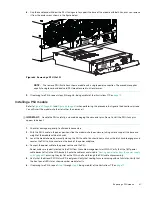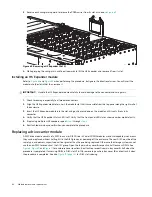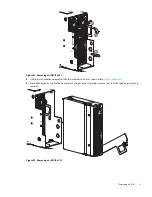
78
Module removal and replacement
6
Module removal and replacement
Overview
This chapter provides procedures for replacing FRUs (customer-replaceable units), including precautions, removal
instructions, installation instructions, and verification of successful installation. Each procedure addresses a specific task.
NOTE:
Unless otherwise noted within a passage pertaining to a particular FRU, the replacement procedure should be
completed within 3 minutes of the removal of a defective module. Do not remove a faulty module unless you have the
replacement module available and ready for insertion into the slot.
ESD precautions
Before you begin
any
of the procedures, consider the following precautions and preventive measures.
Preventing electrostatic discharge
To prevent electrostatic discharge (ESD) from damaging the system, be aware of the precautions to consider when
setting up the system or handling parts. A discharge of static electricity from a finger or other conductor may damage
system boards or other static-sensitive devices. This type of damage may reduce the life expectancy of the device.
CAUTION:
Parts can be damaged by electrostatic discharge. Follow these precautions:
•
Avoid hand contact by transporting and storing products in static-safe containers.
•
Keep electrostatic-sensitive parts in their containers until they arrive at static-protected workstations.
•
Place parts in a static-protected area before removing them from their containers.
•
Avoid touching pins, leads, or circuitry.
•
Always be properly grounded when touching a static-sensitive component or assembly.
•
Remove clutter (plastic, vinyl, foam) from the static-protected workstation.
Grounding methods to prevent electrostatic discharge
Several methods are used for grounding. Adhere to the following precautions when handling or installing
electrostatic-sensitive parts.
CAUTION:
Parts can be damaged by electrostatic discharge. Use proper anti-static protection:
•
Keep the replacement FRU in the ESD bag until needed; and when removing a FRU from the enclosure, immediately
place it in the ESD bag and anti-static packaging.
•
Wear an ESD wrist strap connected by a ground cord to a grounded workstation or unpainted surface of the
computer chassis. Wrist straps are flexible straps with a minimum of 1 megohm (± 10 percent) resistance in the
ground cords. To provide proper ground, wear the strap snug against the skin.
•
If an ESD wrist strap is unavailable, touch an unpainted surface of the chassis before handling the component.
•
Use heel straps, toe straps, or boot straps at standing workstations. Wear the straps on both feet when standing on
conductive floors or dissipating floor mats.
•
Use conductive field service tools.
•
Use a portable field service kit with a folding static-dissipating work mat.
















































